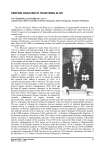Вестник Южно-Уральского государственного университета. Серия: Химия @vestnik-susu-chemistry
Статьи журнала - Вестник Южно-Уральского государственного университета. Серия: Химия
Все статьи: 634

Features of the pnictogen bonds formed by neighboring nitro groups in crystals
Статья научная
Features of pnictogen O…N bonds were considered from the point of view of analyzing various geometric orientations of the neighboring nitro groups NO2…NO2 observed in molecular crystals. The “idealized” orientation for a pnictogen bond, where the nucleophilic fragment of the atom O of one nitro group was directed to the electrophilic site of the atom N of the other one, and the “stacking” orientation, which was characterized by the parallel stacking of nitro groups, differ in the features of the electron density and electrostatic potential distribution between O and N atoms. The applied electronic criterion, obtained with the use of quantum chemical calculations with periodic boundary conditions, confirmed that for the considered O…N interactions the necessary condition for their classification as pnictogen bonds was met.
Бесплатно

Features of thermal decomposition of a new precursor for Mg-Zr mixed oxide preparation
Краткое сообщение
A new peroxo-method for Mg-Zr mixed oxide preparation has been applied. It has been established that this precursor after being heated up to 700 ºC is in the form of poorly crystalline Mg-Zr oxide. Thermal and X-ray diffractional analyses have shown that the oxide phase is formed directly from amorphous peroxocomplex, avoiding formation of intermediate Mg(OH) 2 phase. The peroxocomplex-mediated route allows achieving high degree of molecular homogeneity in the mixed oxide and high distribution of the active sites due to its low crystallinity. The prepared material is a potential catalyst for aldol condensation reaction.
Бесплатно
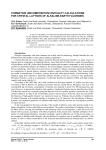
Formation (decomposition) enthalpy calculations for crystal lattices of alkaline-earth fluorides
Статья научная
A series of calculations of structural and thermochemical properties has been carried out for the alkaline-earth fluorides. The calculations have been carried out using the modified model of effective ionic radii and the model of enthalpy calculation for the crystal lattice. The results of the calculations are in accordance with the known experimental data within confidence intervals.
Бесплатно
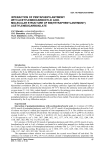
Статья научная
Bis(tetraphenylantimony) acetylenedicarboxilate (1) has been synthesized by the interaction of pentaphenylantimony with acetylenedicarboxylic acid (mole ratio 2:1 or 1:1) in toluene. In molecule 1 the acid anion has the bridging role and bonds Ph4Sb fragments. The antimony atoms have distorted trigonal bipyramidal coordination with the oxygen atom in the axial position. The Sb-O bond lengths are 2.287(4) and 2.389(4) Å, the Sb-C bond lengths are 2.110(7)-2.179(6) Å and 2.108(6)-2.165(6) Å.
Бесплатно
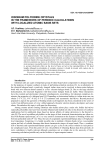
Статья научная
Methodological features of the crystal structure modeling for compounds with three-center halogen bond formed by two electron donors S-I+-S in polyiodide crystals were considered within the framework of periodic calculations based on localized atomic orbitals. The analysis of applying the different basis sets, effective core potentials, density functional theory functionals, and Grimme dispersion corrections revealed their effect on the geometric, electronic and vibrational properties obtained in calculations. Distribution of S-I bond lengths in S-I+-S fragment was analyzed. The effect of hybrid functional was demonstrated in the significant elongation of S-I distance. The treatment of dispersion interactions via Grimme approach did not significantly influence obtained results. The calculated vibration modes in medium wavenumber region of characteristic cationic stretching vibrations were validated according to experimental Raman spectra and were found to be in good agreement for C-N, C-C and C=S stretching vibrations. Small-core effective potential was shown to be effective for representation of bond lengths in S-I+-S fragment and gave reasonable results for vibrational data for cationic stretching vibrations. Taking into account relativistic effect on the level of basis set led to fine reproducibility of S-I bond lengths although in polyiodides of complex structure it should be treated with caution due to possible incorrect representation of interanionic distances.
Бесплатно
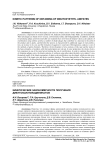
Kinetic patterns of obtaining of dibutoxyethyl adipates
Статья научная
It is known that adipic acid esters are widely used in various industries, for example, as plasticizers, components of aviation synthetic oils, hydraulic and hydraulic brake fluids, and instrument oils. Their advantages are based on low toxicity, environmental safety and biodegradability. In addition, methods for producing adipic acid from renewable raw materials have now been developed. Classic acid catalysis of esterification using sulfuric acid has a number of disadvantages that contribute to a decrease in the yield of the product and its purity, and therefore the process is characterized by additional stages of ester purification, an increase in its cost and the formation of aggressive wastewater. Heterogeneous catalysis is one of the methods of green chemistry. Therefore, the development of new catalysts of this type and the study of the basic principles of synthesis with their participation are relevant. In ester production, the choice of alcohol component is one of the main factors limiting the rate of esterification. In order to optimize the process of obtaining adipate esters, the kinetic patterns of synthesis using ethoxylated alcohols were studied. A mathematical model of the kinetic parameters of adipic acid esterification was developed, which provides maximum yield of the target ester and shorter synthesis duration. The main characteristics of the process of obtaining adipates of ethoxylated alcohols using catalysts of heterogeneous and homogeneous nature are considered.
Бесплатно
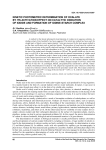
Статья научная
A method for the kinetic photometric determination of oxalate ion in aqueous solutions, including extracts from foodstuffs, has been suggested. The initial rate method has been used: the straight parts of kinetic curves (approximately 5 min) are processed by the least square method to get the slope coefficients used as analytical signals. The procedure is based upon the oxalate ion action as an activator in the iron(II)-catalyzed reaction of iodide oxidation by potassium bromate. Unlike the previously used light absorbance in the UV region, the suggested procedure controls the rate of the iodine-starch complex formation at 590 nm. The greatest initial rate for the reaction is at pH 5.05 of the acetate buffer solution and the optimal concentration of soluble starch 0.30 mg/mL. The calibration graph is linear in the oxalate concentration range (0.1-10) mg/mL. In this interval precision error varies between 0.67 % and 4.71 %, accuracy error is within (0.22-9.30) %. The procedure has been applied to food analysis by the standard addition method. Aqueous extract has been obtained from 2.5 g of finely chopped sample of raw beet, stirred with 100 mL of water for 1 h, centrifuged, filtered, and quantitatively transferred to 250-mL volumetric flask. Determination of oxalate in 1-mL aliquot has required the same volume of colored beet extract for a reference solution, but otherwise the procedure stands valid. The oxalate content has been found to equal (379 ± 2) mg/g of the raw beet (P = 0,95; n = 4), with 0.6 % precision error and 3.0 % accuracy error.
Бесплатно
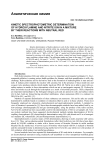
Статья научная
Kinetic determination of hydroxylamine in soils by the initial rate method is based upon the reaction of neutral red with the nitrite ion, produced by oxidation of hydroxylamine with iodate in acidic media. The optimal conditions for determination are as follows: 0.3 mol L-1 H2SO4, 0.024 mol L-1 KIO3, 6.92×10-5 mol L-1 neutral red. Hydroxylamine can also be determined in mixtures with nitrite ion, if the nitrite content has been found separately at the same conditions without iodate. The calibration graphs are linear in the range (3-27) μmol L-1 of NH2OH and (4-46) μmol L-1 of NO2-. The reproducibility errors are 3.3 % and 1.8%, the relative errors of determination prove to be 2.6 % and 2.1 %, for hydroxylamine and nitrite ion, respectively.
Бесплатно

Methods for calculating and matching thermodynamic properties of silicate and borate compounds
Статья научная
New methods for processing the experimental and calculated thermodynamic data have been elaborated and the existing ones have been improved. The developed approaches provide a physically reasonable description of the first-order phase transitions, which makes it possible to compare and correct the values of their thermodynamic properties, as well as to calculate the thermodynamic parameters of unstudied compounds. Regression equations have been proposed for calculating the standard entropy and enthalpy of formation of lithium, sodium, and potassium silicates and borates. The resulting entropy and enthalpy values for 14 alkali metal silicates and 12 alkali metal borates can be used to optimize the technological processes for manufacturing glass, ceramics, and coatings.
Бесплатно
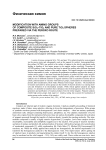
Статья научная
A series of porous composite SiO2-TiO2 and pure TiO2 spherical particles were prepared via the peroxo route and subsequently used as the support for catalyst. Aminopropyltrimethoxysilane (APTMS) was grafted to the surface of support in the strictly unhydrous media leading to bonding of free amino groups to the support surface covalently. Procedure of APTMS grafting is easy to perform and may be spread for grafting other different functional groups to the inorganic surfaces of the catalyst support. The support samples were calcined at various temperatures in order to optimize the preparation conditions and boost the density of surface amino groups. It has been found that the quantity of grafted APTMS varies insignificantly for the different support samples. Grafted amino groups would be applied as active catalytic sites in different reactions of organic chemistry such as acylation of amines and alcohols, polymerization of lactones with hydroxyl groups, isomerization of unsaturated compounds, aldol condensation, Diels-Alder, Michael, Knoevenagel reactions. The mechanisms of reaction activation by amino groups are the transfer of electron density to a reacting molecule and formation of an intermediate complex. While widely applied catalysts are liquid amines, it is desirable to transform these substances into the heterogeneous form for better regeneration and purification of reaction products from the initial reagents. Prepared catalysts exhibit high amino groups load equal to 1 mmol/g, taking into account the localization of amino groups on the surface of the catalyst.
Бесплатно
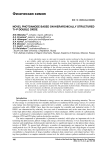
Novel photoanode based on hierarchically structured Ti-P double oxide
Статья научная
The study of trialkylborane as a component of the initiating system with oxygen was carried out using the example of graft polymerization of alkyl(meth)acrylate vinyl butyl ether copolymer units on pectin polysaccharide. The amine complex triethylborane-hexamethylenediamine was introduced into a boiling mixture of an aqueous solution of pectin in vinyl butyl ether, after which a solution of the active monomer, alkyl(meth)acrylate, containing methacrylic acid, was introduced by the compensation method to isolate triethylborane from the complex. As a result of synthesis from a mixture containing butyl acrylate, three immiscible parts were formed: organic, aqueous, and between them a “sponge” that did not dissolve in any of the phases. In the case of methyl methacrylate, only two parts were formed in the mixture: organic and aqueous. Water-soluble and organic polymers were dried under vacuum conditions to constant weight at T = 20-25 °C. Gravimetric analysis showed that the “sponge” was a mixture of water-soluble and organic polymers at 50:50 ratio. To do this, the dried polymers were dissolved alternately in water and vinyl butyl ether. Graft copolymers pectin-methyl methacrylate-vinyl butyl ether and pectin-butyl acrylate-vinyl butyl ether were isolated from the aqueous phase of the synthesized systems, in relation to the introduced acrylate. In comparison with the original pectin, the molecular weight of the water-soluble fraction increased significantly. Comparison of the IR spectrum of the graft copolymer pectin-methyl methacrylate-vinyl butyl ether with the IR spectra of pectin and the IR spectrum of pectin-methyl methacrylate indicated that all the bands characteristic of pectin, polymethyl methacrylate, and polyvinyl butyl ether were observed for the new polymer sample. Freeze-dried samples of pectin and pectin-methyl methacrylate-vinyl butyl ether graft copolymer were examined using scanning electron microscopy. A comparative analysis showed a change in the structure of pectin fibers as a result of its copolymerization with a copolymer of methyl methacrylate-vinyl butyl ether. The obtained data confirm the addition of synthetic polymers alkyl (meth) acrylate-vinyl butyl ether to the basis of the pectin macromolecule. New substances are polymer molecules containing natural and synthetic fragments with an ordered structure. Such compounds are promising as the basis for wound healing coatings.
Бесплатно
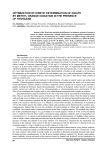
Статья научная
Instead of the fixed time method the difference in induction periods of decolorization of a blank solution and a sample solution has been suggested as analytical signal for iodate ion determination by Landolt reaction of methyl orange with potassium bromate in the presence of hydrazine. Optimal conditions are: 0.024 M H 2SO 4,2x10 -6M methyl orange, (5-6)x10 -5 M KBrO 3, 1x10 -5 N 2H 4. Calibration curve is linearin (0.06-2.4) µg/mL range, reproducibility error is less than 2.7%, relative error of determination is less than 3.3 %, for aqueous solution analysis.
Бесплатно
![Oxidation of tri( o-tolyl)antimony by tert-butyl hydroperoxide. Molecular structures of bis[µ 2-oxo-tri(o-tolyl)antimony] and µ 2-oxo- bis[( tert-butylperoxy)tri( o-tolyl)antimony] Oxidation of tri( o-tolyl)antimony by tert-butyl hydroperoxide. Molecular structures of bis[µ 2-oxo-tri(o-tolyl)antimony] and µ 2-oxo- bis[( tert-butylperoxy)tri( o-tolyl)antimony]](/file/thumb/147160326/oxidation-of-tri-o-tolyl-antimony-by-tert-butyl-hydroperoxide-molecular.png)
Статья научная
Tri( o-tolyl)antimony oxidation by equimolar amount of tert-butyl hydroperoxide in diethyl ether led to the formation of bis[µ 2-oxo-tri( o-tolyl)antimony] (1). At the molar ratio of reactants 1:2 or 1:4 µ 2-oxo- bis[( tert-butylperoxy)tri( o-tolyl)antimony] (2) has been formed. According to the X-ray analysis data, antimony atoms are in the trigonal bipyramidal coordination in molecules 1 and 2. The bond lengths Sb-O vary within the ranges 1.937(2)-2.078(2) Å (1) and 1.975(17)-2.216(15) Å (2).
Бесплатно
![Peculiarities of the reactions of tri(meta-tolyl)antimony and tri(ortho-tolyl)antimony with 2-nitrobenzaldoxime. The molecular structures of bis(2-nitrobenzaldoximato)tri(meta-tolyl)antimony, µ2-oxo-bis[(2-nitrobenzaldoximato)tri(meta- tolyl)antimony] and bis(2-nitrobenzaldoximato)tri(ortho-tolyl)antimony Peculiarities of the reactions of tri(meta-tolyl)antimony and tri(ortho-tolyl)antimony with 2-nitrobenzaldoxime. The molecular structures of bis(2-nitrobenzaldoximato)tri(meta-tolyl)antimony, µ2-oxo-bis[(2-nitrobenzaldoximato)tri(meta- tolyl)antimony] and bis(2-nitrobenzaldoximato)tri(ortho-tolyl)antimony](/file/thumb/147160357/peculiarities-of-the-reactions-of-tri-meta-tolyl-antimony-and-tri-ortho-tolyl.png)
Статья научная
Bis(2-nitrobenzaldoximato)tri(meta-tolyl)antimony (1), µ2-oxo-bis[(2-nitrobenzaldoximato)-tri(meta-tolyl)antimony] (2) and bis(2-nitrobenzaldoximato)tri(ortho-tolyl)antimony (3) have been obtained by the reactions of tri(meta-tolyl)antimony and tri(ortho-tolyl)antimony with 2-nitrobenzaldoxime in the presence of an oxidizing agent (hydrogen peroxide or tert-butyl hydroperoxide). Compounds 1-3 have been characterized by X-ray diffraction analysis.
Бесплатно
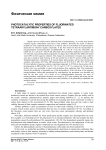
Photocatalytic properties of fluorinated tetraarylantimony carboxylates
Статья научная
Organic dyes are widely used in different kinds of manufacturing. As a result, they become common organic contaminants, and lead to water pollution. Therefore, the search of effective methods for such compound destruction is of interest. One of such methods is the photocatalytic destruction by antimony organic compounds. It has been found out that the incorporation of tetraarylantimony monocarboxylates (Ar4SbOC(O)R, Ar = Ph, R = C6F5 (1), CF2CF2CF3 (2), CF2Br (3); Ar = p-Tol, R = CF2CF3 (4), CF2CF2CF3 (5)) and further irradiation of solutions with UV radiation causes photocatalytic degradation of organic dyes methylene blue (MB) and methyl violet (MV) in their aqueous solutions. The change of concentration of organic dyes could be seen due to change in peak intensity at 554 nm and 665 nm in the UV spectra of MB and MV. Tetraphenylantimony carboxylates 1-3 showed higher photocatalytic activity than tetra(p-tolyl) antimony carboxylates 4, 5. Thus, MB decomposition was 90.5-98.8 %, MV: 97.7-100 % after 60 min irradiation of aqueous solutions containing compounds 1-3. While in the presence of 4, 5, decomposition of MB and MV was 55.1-53.2 % and 71.2-78.7 %, respectively. In both cases, methyl violet was susceptible to more total destruction than methylene blue. The experiments showed the probability of repeatable use of the photocatalysts. After full decay of the pigment, tetraarylantimony carboxylate precipitated by centrifugation, the precipitate was decanted and used for the next cycle. As a result of two photodegradation processes, the mass of tetraarylantimony carboxylates decreased on average by 50 % after washing and drying, but the carboxylates were still effective, which proved the possibility of the photocatalyst repeatable use and their stability.
Бесплатно
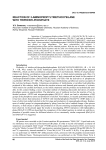
Reaction of 3-aminopropyltriethoxysilane with triphenylphosphate
Статья научная
Interaction of 3-aminopropyltriethoxysilane RNH 2 [R = (EtO) 3SiCH 2CH 2CH 2] with triphenylphosphate (PhO) 3P=O proceeds at temperature 180-200 °C and leads to formation of quaternary ammonium salt of phenylphosphoric acid [PhOP(O)O 2] 2-[PhH 2NR] 2+, which turns into liquid silicon-containing oligoamidophosphates RNH[P(O)(OPh)NR] nP(O)(OPh)NHR and phenol at high temperature. The latter transesterifies the original 3-aminopropyltriethoxysilane and the obtained products. With the use of high-temperature vacuum rectification liquid oligomers and the solid cross-linked polymer have been isolated. Heating of the solid polymer up to 1000 °C in inert atmosphere results in the amorphous phase, containing SiO 2 and NPO. The reactions of 3-aminopropyltriethoxysilane with triphenylphosphate and trimethylphosphate have been compared.
Бесплатно
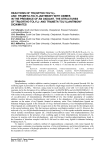
Статья научная
The triarylantimony dioximates: ( о-СH 3C 6H 4) 3Sb(ON=CHC 6H 4N(CH 3) 2-4) 2 (1), ( о-СH 3C 6H 4) 3Sb(ON=CMePh) 2 (2), ( m-СH 3C 6H 4) 3Sb(ON=CHC 4H 3O) 2 (3) were obtained from the reactions of tri( ortho-tolyl)antimony and tri( meta-tolyl)antimony with appropriate oximes in the presence of hydrogen peroxide and tert-butyl hydroperoxide. According to the X-ray analysis data, antimony atoms are bound to oxygen atoms of axial oximate ligands in the trigonal bipyramidal coordination in molecules 1-3. The peculiarities of molecular structures are short intramolecular contact Sb∙∙∙N, which is 1 Å less than the sum of Van der Waals radiuses.
Бесплатно
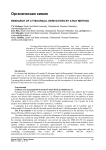
Research of 2-thiouracil derivatives by X-ray method
Статья научная
2-Propargylthio-6-methyl-5-ethyl-4(3H)-pyrimidinone has been synthesized by alkylation of S-sodium salt of 6-methyl-5-ethyl-2-thiouracil with propargyl bromide. It has been found by X-ray method that S-derivatives of 2-thiouracil are in the tautomeric form with the proton at the nitrogen atom N3. The substitute at the sulfur atom is within the plane of pyrimidine ring at the angle 59-84°. The 2-alkylthio-4(3H)-pyrimidinones molecules are combined in dimers with formation of two intermolecular hydrogen bonds.
Бесплатно


